|
Greatest Oldies
Mosaic, Torch Bearer for Dressage in Australia
April 20, 2010
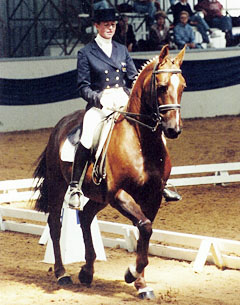 Some Europeans might have rubbed their eyes when they saw Mosaic, a diminutive horse with a rather tall lady aboard, for the first time. Carrying the Australian flag on the saddle pad they seemed to go on with a tradition that started in 1980 when Australia sent a dressage rider to the Olympics for the first time. The country continued to do so with little success until the 1990s. Initially nobody assumed that this liver chestnut would change Australia’s reputation from rather exotic dressage country to a nation seriously devoted to the discipline. The story of Mosaic is proof that one could ride on a half pony, come from down under and yet be serious about international competition. Some Europeans might have rubbed their eyes when they saw Mosaic, a diminutive horse with a rather tall lady aboard, for the first time. Carrying the Australian flag on the saddle pad they seemed to go on with a tradition that started in 1980 when Australia sent a dressage rider to the Olympics for the first time. The country continued to do so with little success until the 1990s. Initially nobody assumed that this liver chestnut would change Australia’s reputation from rather exotic dressage country to a nation seriously devoted to the discipline. The story of Mosaic is proof that one could ride on a half pony, come from down under and yet be serious about international competition.
Mosaic was born in New Zealand in 1983 and is an offspring of Witzbold, one of the first imported Hanoverian sires in this country. His father was well bred by Winnetou out of a Lungau mare and went on to sire several other dressage horses in kiwi country, which competed internationally, e.g. Mosaic’s full brother Playskool.
Mosaic’s dam was a pony size mare by Sharam ox, so in the end Mosaic was standing barely 160 cm and missed the big lines of a typical European warmblood. He became a registered NZ Hanoverian and his breeder Eric Ropiha, a well-known horseman in New Zealand, sold him as a 3 ½ years old to Sharon Field, one of the country’s first international dressage riders. Sharon trained Mosaic with the help of her Australian based trainer Clemens Dierks up to Grand Prix and aimed to represent her country in the Olympics.
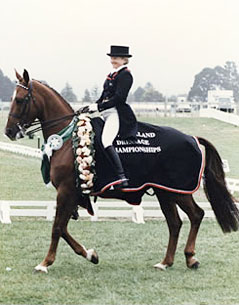 The horse had no serious rivals in his home country so Sharon took him over to the Australian CDIs in Sydney, Lochinvar and Adelaide from 1991 to 1993 and always placed him in the top 4. When he placed 2nd in all his starts at the CDI Lochinvar Sharon hoped to get him to the 1996 Olympic Games. The horse had no serious rivals in his home country so Sharon took him over to the Australian CDIs in Sydney, Lochinvar and Adelaide from 1991 to 1993 and always placed him in the top 4. When he placed 2nd in all his starts at the CDI Lochinvar Sharon hoped to get him to the 1996 Olympic Games.
At the National Australian Championships in Adelaide the diminutive liver chestnut gelding caught Mary Hanna’s eye. Mary was an accomplished national Grand Prix rider and ran Statene Park, a renowned warmblood stud in Australia, with her late husband Gert Donvig. Mary recalls she liked Mosaic’s lovely movements, especially his rhythmical and cadenced trot with his very active hindlegs. But she thought the gelding was very tiny and scrawny looking in his neck, so she did not consider Mosaic her first horse which would take her from national to international level.
At the time Mary had a self trained Grand Prix horse named Welcome Stranger, but Clemens Dierks, who took over her training after her husband had died, did not like the horse and advised her to sell him when Mary got a good offer from Japan. Clemens knew Mary was longing to represent her country at the 1994 World Equestrian Games in The Hague and he also knew Mosaic was for sale after it had been decided not to send a dressage rider from New Zealand to Atlanta. Mary was skeptical to take a look at this small horse since she was rather tall, but she trusted her trainer and flew to New Zealand to meet Mosaic.
“After my first ride I thought: no, this cannot work. I was used to have really nice looking good type of horses and Mosaic was so small and funny looking,” Mary admitted. Finally she bought him, trusting Clemens’ judgment , after having decided to overlook Mosaic’s small stature. Luckily Mary soon found out that "Mosaic made up for it with his big heart and strong personality.”
It took some time to tune in together as a partnership, mainly since Mary was much taller than Mosaic’s previous rider and was used to a bit different aids. So their first show together was a small one at Prix St. Georges- level, but both soon moved to Grand Prix and became the National Grand Prix champions in their first attempt together.
Mary’s longtime dream to represent Australia internationally was realized not long after when she flew with “Robbie,” as the horse was nick-named, to Holland to compete in the 1994 WEG in The Hague. In a large field of competitors he became the highest placed Australian team horse and Mary realized that Mosaic needed the really big occasions to show himself off.
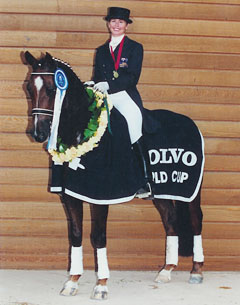 A year later he won at the CDI Sydney in May ahead of the elegant thoroughbred Temuchin right before flying back to Europe to represent Australia in the 1995 European Championships in Mondorf, Luxemburg. Teams from overseas were allowed to take part in these "open Europeans" to qualify for the Olympic Games. Robbie once more was the team’s anchor and finished in a remarkable 33rd place out of 60 starters. Two months later, back on his home continent, he won the Volvo World Cup League Final and qualified for his first World Cup Final to be held in April 1996 in Gothenburg, Sweden. A year later he won at the CDI Sydney in May ahead of the elegant thoroughbred Temuchin right before flying back to Europe to represent Australia in the 1995 European Championships in Mondorf, Luxemburg. Teams from overseas were allowed to take part in these "open Europeans" to qualify for the Olympic Games. Robbie once more was the team’s anchor and finished in a remarkable 33rd place out of 60 starters. Two months later, back on his home continent, he won the Volvo World Cup League Final and qualified for his first World Cup Final to be held in April 1996 in Gothenburg, Sweden.
Mary was aiming for the Olympics as an individual and the final gave her the opportunity to show the international judges what a quality little horse she was riding. Funnily Robbie seemed to be more respected abroad than in Australia. “At home some people were rather scathing about our going to the Olympics. One of our officials even had told me it was ridiculous to think I could go on such a ponylike horse, which was far too small and had no talent!” Mary recalled. However she planned to fly over to Europe prior to the WC final and stay there to train with Kyra Kyrklund in Sweden before departing to Atlanta.
But her worst travel experience ever almost ruined her Olympic dream before it had begun.
Mary, Mosaic and his groom started the flight around the world with two showjumpers on the plane. Unfortunately the plane broke down in Singapore and got stuck for hours in which none of the horses were allowed to leave the plane. Mosaic suffered from it and became very ill with travel sickness. He developed a high temperature and could hardly stand when the plane finally neared its destination after more than 50 hours.
“I thought he was going to die,” said Mary. Once off the plane the responsible vet thought poor Robbie had an exotic Australian disease and put him in quarantine in a pig pen!
Mary couldn’t believe it, complained bitterly and succeeded in the end by getting a stable and proper treatment for her brave horse. “Robbie was so tough, such a little soldier and recovered quickly. Within two weeks he competed at the WC final and did the test of his life!”
After Gothenburg both moved to Kyra Kyrklund to start their Olympic preparations. Though Mosaic was a small horse he owned the unique ability to show such big airy flying changes that they sometimes would not fit on a diagonal. At the WC final he had impressed with 28 faultless one time changes on three loop serpentines. The Hanoverian had also great half passes and quite a nice passage, but the piaffe was a bit his weak point.
One day Kyra showed Mary a video tape with a very old trainer teaching piaffe in hand. “I thought this should be a big help for the problem, ” reminisced Mary and completely changed her piaffe training. Looking back on her fantastic time with Kyra, she thinks it was a great experience. "Kyra was a wonderful mentor and trainer, who showed me the way to my first Olympic experience."
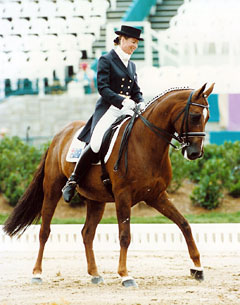 Mosaic traveled together with Kyra’s Swedish stallion Flyinge Amiral and the Swedish team horses down to Münster in Germany and flew to Atlanta with almost all other Olympic dressage horses and riders. In Atlanta “Kyra had organized a training camp for us with friends of hers near by Atlanta and the whole thing was much fun.” Mosaic traveled together with Kyra’s Swedish stallion Flyinge Amiral and the Swedish team horses down to Münster in Germany and flew to Atlanta with almost all other Olympic dressage horses and riders. In Atlanta “Kyra had organized a training camp for us with friends of hers near by Atlanta and the whole thing was much fun.”
Mary admits she never expected a great result. No Australian was ever able to qualify for the Special and even Mary’s home trainer Clemens Dierks did not assume her to do it and had booked his flight back right after the Grand Prix. But where other horses became tensed and made mistakes in the atmosphere of a big stadium Robbie, just loved it once again! “When he walked into the stadium he felt like he grew a hand bigger!”
To the surprise of everyone the smallest horse in the field placed a remarkable 24th of 49 starters. One judge had even placed him 16th. Mary was overjoyed to have become the first Australian ever to qualify for the next round and poor Clemens Dierks had to completely rearrange his travel plans. Mosaic finished 23rd overall, but more importantly “this was the turning point for Australian dressage because it proved you could ride on a small, plain horse and be serious. After that people got a lot more serious about the possibility of getting to Europe and competing internationally.” Mary also loves to think back that the European judges gave Mosaic a fair go and seemed to respect him a lot more than the ones in Australia did.
Robbie became a regular traveler between Australia and Europe. In Australia he was virtually impossible to beat, though he was sometimes hard to motivate in his training.
So Mary never trained him too hard or too long. Often she replaced work with a ride in the bush to keep her gelding fresh and make it more fun for him as he loved being hacked.
Apart from his riding Mosaic was turned out daily. Though he always thought he should be given more than one hour a day, his paddock pleasure had to be limited because of his easily expanding girth
Mary, among others, thinks Mosaic’s great personality enabled him to overcome his lack of size to compete successfully. He qualified for two more World Cup finals. As small as Robbie was he bossed all his grooms and everyone around at home. He once even put a groom who treated him aggressively out of his stable. One had to go into the stable with sugar and never growl at him. “Robbie is always right and then everyone gets on just fine,” Mary explained.
In 1998 Mosaic once again flew over to Europe to represent Australia for the ninth time at the World Equestrian Games in Rome. But for the first time he was not the team’s best scoring horse and placed only in the mid field. “By then it was his 5th trip around the world in 5 years. I don’t think any other horse has survived such a program of travel and it finally became a bit much, so the following year I retired Robbie from international competition.”
Mosaic became a wonderful schoolmaster for Mary’s talented daughter Gitte Donvig, who had many successful competitions with him. In 2000 he was finally retired from the sport in a moving ceremony in Werribee and as always he thought the thousands in the crowd were there for him only. Robbie went on to teach many of Mary's privileged pupils, who learnt how to ride flying changes properly. Afterwards Mosaic finally retired to the pasture.
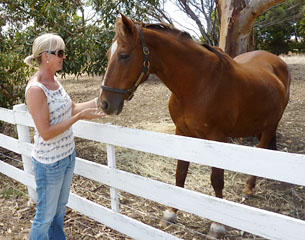 Currently the 27-year old professor is, according to Mary, in excellent health and baby-sitting Mary’s Grand Prix horse Rambo, who is recovering from an injury. “Even at this age his strength of character shines out of him. He still can do passage like a champion if his mood takes him and I feel there are a lot of good years left,” said Mary. Currently the 27-year old professor is, according to Mary, in excellent health and baby-sitting Mary’s Grand Prix horse Rambo, who is recovering from an injury. “Even at this age his strength of character shines out of him. He still can do passage like a champion if his mood takes him and I feel there are a lot of good years left,” said Mary.
Mosaic never won a medal, but he set his own records by being the first dressage horse bred in New Zealand to compete in the dressage Olympics. At the time he was also the first dressage horse for Australia to reach the Olympic individual competition and the only horse from Australia to compete in three World Cup Finals.
Mary confirmed her old companion had an undeniable impact on her: “It is all due to this wonderful little horse that I was totally hooked on the life of an international dressage rider and had the thirst to go on to do two more Olympics. I am still trying for my fourth. Robbie is a much loved member of our family.”
Related Links
Dr. Reiner Klimke's Ahlerich
Nicole Uphoff's Rembrandt: A Living Work of Art
Gauguin de Lully CH, a Swiss Gentleman
Limandus, The Happy Athlete
Dante, One in a Century
Aktion, King of the Kur
Walk on Top, Nomen Est Omen
|
